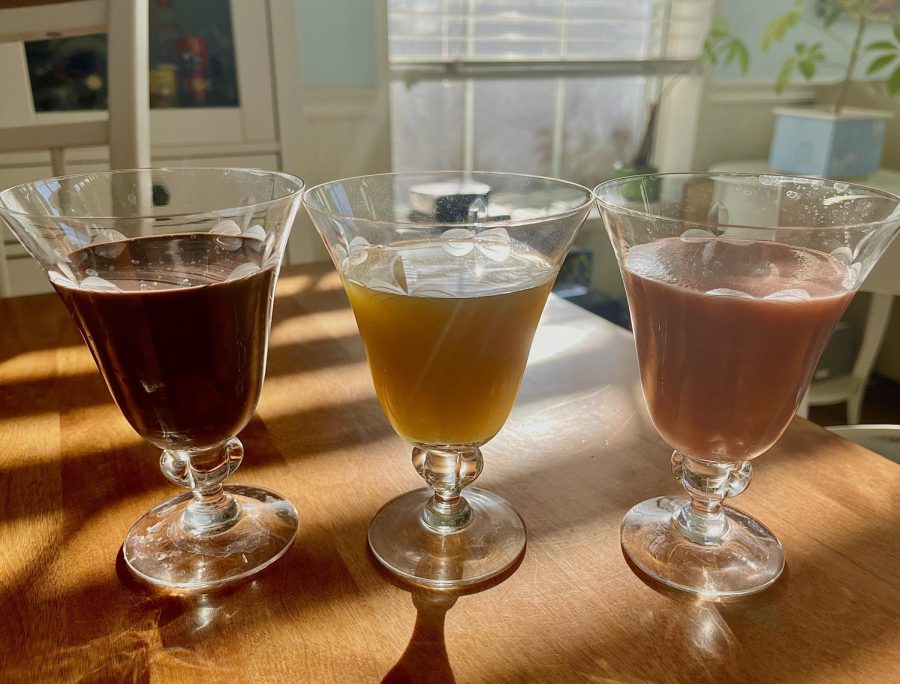Juices to introduce into your diet this summer
Juiced grasses and produce provide many heath benefits without an overload of sugar.
May 28, 2022
Juicing involves squeezing fruits and vegetables into their liquid form. It’s a quick, easy way to get in important nutrients. While fruit juices like apple, orange, or cranberry are the most common, there are other, less-known juices—those that may deserve a try this summer.
Wheat grass shots
Wheat grass shots are exactly what they sound like—grass cold pressed into juice. Because these juiced plants have not been subjected to high heat, these shots are a good way to consume helpful enzymes and vitamins that might have been reduced had the grass been cooked instead.
Most of wheat grass’ appeal comes from chlorophyll. Making up 70% of the shot, chlorophyll is a pigment that, when broken down, turns into a water-soluble salt called chlorophyllin. This chlorophyllin reacts with irregular cells and removes them from the body.
These shots also contain a large amount of magnesium, an oxygen-binding element that boosts hemoglobin production.
Ginger shots
In ancient India, heralded as the “Great Cure,” ginger was used to ward off a variety of ailments including colds and joint pain. While modern medications have since replaced ginger’s curative importance, ginger is still loaded with health benefits.
Packed with gingerols, parasols, and zingerone—essentially, antioxidants and anti-inflammatories—ginger has long been a go-to for dealing with nausea, digestive issues, and intestinal cramping. Other benefits include reducing blood sugar levels, boosting weight loss, and decreasing hunger levels.
The only downside with ginger, really, is its pungent, peppery taste. Sweetening the shot with lemon, orange, or manuka honey can do just the trick.
Celery juice
You may know celery for its stalks—a popular, low-calorie snack among dieters—but celery juice is quickly making a comeback. The juice includes a variety of vitamins and minerals (e.g. Vitamin A, C, K, calcium, and magnesium).
The compounds in celery leaves and seeds are phytochemicals and antioxidants, as well. These can relieve inflammation and prevent cancer.
Kombucha
Kombucha has long circulated the health community as a trendy wellness drink. In recent years, it has moved from niche food stores to the shelves of big name groceries.
Kombucha is black or green tea with added bacteria, yeast, and sugar. After fermenting for a week, the drink produces a film of bacteria and acetic acid—which may sound off putting, at first.
But the bacteria grown has probiotic function, helping with digestion, inflammation, and weight loss, while acetic acid can kill potentially harmful microorganisms, protecting against cancer and heart disease—as well as managing type 2 diabetes.
Studies have suggested that the tea’s antioxidants may reduce liver toxicity caused by toxic chemicals by up to 70%, as well.
Bone broth
As the one exception to the list, bone broth is used as a soup, not a drink. Used as a base for soup, stews, and risottos, this protein-rich liquid contains collagen, a structural protein that breaks down into amino acids like gelatine and glycine.
Gelatine has been connected to injury prevention and tissue repair. Glycine, meanwhile, supports intestinal immunity and sleep patterns.
Collagen itself improves skin hydration and elasticity.
To drink or not to drink
Despite all their advantages, fruits and vegetables do lose fiber when squeezed into their liquid form. Fiber plays an important role in bowel health by softening, and increasing the weight of, stool.
Of course, juicing can be a great way for people to get the nutrients they need without needing to buy and eat a large quantity of whole foods.
But in the end, juicing is “no healthier than eating whole fruits and vegetables,” according to the Mayo Clinic. Sticking to a balanced diet and maintaining an active lifestyle is the way to go when it comes to being the healthiest you can be.





